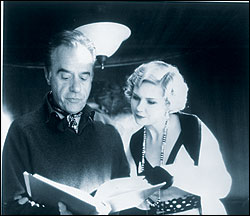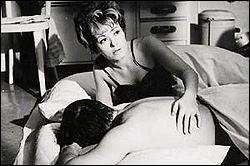THIS COLLECTION of 25 profiles of famous actors would have been better had it been shorter. Across the 528 pages of Who the Hell’s in It (Knopf, $35), Peter Bogdanovich, the journalist turned film director turned journalist again, spends too much time in old-world idolatry. He refers incessantly and uncritically to the “golden age” of Hollywood, and he mars a great many of these remembrances with excessive sentiment, with a need to reassure the reader or, more likely, to reassure himself.
In an otherwise ho-hum essay on Dean Martin, Bogdanovich leads with this unassailable truth: ” . . . [W]hat gets to you as you age is eternally about who and what you grew up with. You ache not just for the performers’ past, but for your own.” That ache is the author’s real subject, here presented under 25 different names.
His short, evocative vignette of Montgomery Clift comes off best. What sets this profile apart is that Bogdanovich doesn’t try to make us feel better—he simply tells a good story without getting in the way. Three other Hollywood sketches are outstanding: Cary Grant, John Cassavetes, and Jimmy Stewart, all of whom Bogdanovich knew as friends over a span of years.
The recollections that build those essays are droll, poignant, and well told—proof of what Bogdanovich can achieve when he doesn’t overreach for significance. The Grant profile has the most apt summation of the cigarette habit’s cyclical nature. “One time I told him I’d stopped smoking, and he said, ‘That’s good—that means you like yourself again!'” And Bogdanovich offers an incisive précis of Stewart’s appeal: ” . . . [N]o other male film star was ever better at showing the real pain and fear caused by violence.”
Cassavetes emerges as uncommonly generous, and there’s superb commentary on his filmmaking. Elsewhere in the book, there are less successfully written yet still worthwhile portraits of Marlene Dietrich, River Phoenix, and Henry Fonda.
Overall, the author compromises Who the Hell’s in It with his indefatigable penchant for irrelevancy. His prose all too often drowns in hooey, such as this note on a 1976 Sinatra performance at Caesar’s Palace: “In those days, there was only one fellow who brought the high rollers to town, and that was old Caesar’s countryman from Hoboken, New Jersey.” And of a wrap party held in a low-rent karaoke bar, we receive this stupefying tidbit, ” . . . [T]he club’s roof started to leak, but it couldn’t dampen anyone’s spirits.”
Bogdanovich constantly calls filmmakers “picture makers,” sometimes one word, sometimes two. He labors to forge connections between events that are only tenuously related. Consider this high-flying pretzel knot into which Bogdanovich weaves himself:
Had we examined closely enough what exactly the picture-shows had been doing to us all these years? The question had taken on a far more ironic, bizarre and ominous dimension in 1981. A hundred and fifty years before, an actor had assassinated the President of the United States, but in the second year of the eighties, President Reagan, formerly an actor, was nearly assassinated by a movie fan. This person was inspired not by political motives, but rather by the machinations of a demented fictional character (Travis Bickle in Martin Scorsese’s Taxi Driver) . . . glorified through the personality of another actor (Robert DeNiro) who would, the day after the assassination attempt, win (for his role in Scorsese’s Raging Bull) the Academy Award as best actor of the year. . . . What had happened to the country, and to the movies?
The majority of Who the Hell’s in It reads like the same tripe, as if the writer felt compelled to stuff the book with every observation that ever queued in his head.






